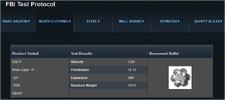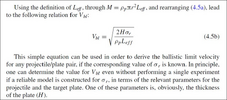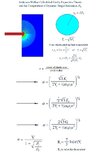OK, a little bit of background so you'll understand why I ask the questions I do.
I'm an engineer, but not a mechanical engineer. I work as a nuclear engineer in a shipyard and have two additional years as an operator of naval nuclear propulsion plants. My degree is in EET and my time in the Navy was spent as a Reactor Operator.
I'm familiar with aspects of Fracture Mechanics as related to the development of certain temperature/pressure operating curves that must be operated within, so I understand brittle fracture, ductile failure, and in general the various tests utilized to generate these curves and how they're adjusted for the design lifetime of a reactor pressure vessel.
This is a practical understanding of Fracture Mechanics as specifically applied to my field, not a degreed-in-the-field understanding of a Mechanical Engineer, mind you.
SO...
"'U' is the projectile-target interface velocity at the bottom of the crater during an impact into a ductile (or brittle) material measured at the tip of the projectile as it advances (and erodes) through the target."
I understand that this is a property determined as an object is actually advancing through a material. Which makes sense because it's a "penetration" velocity. If the projectile was too slow, then it wouldn't penetrate, therefore... And I'll make a basic assumption that this velocity is simply determined experimentally.
But what materials was this equation developed for? This value is dependent upon the densities of the target and the projectile exclusively, with the exception of compressibility according to your explanation. Materials with a low fracture toughness would have a different U value than materials with a high fracture toughness, for a given density. HOWEVER...some materials react differently even if they are of similar density to others based on other mechanical properties.
Non-newtonian fluids come to mind, for example. And glass is a pretty weird substance all by itself. It's an amorphous solid (basically a liquid, but acts like a solid because of its uniquely rigid structure). Its properties can be varied radically by composition, treatment, and manufacture. And then there's laminated glass, such as American automotive windshields.
So glass, tempered or not, does not react to penetration like metals. It may be similar, but it's not going to be the same. Glass will fracture/crush at the point of impact and those glass fragments will have a significant impact on bullet path as a result, because those millions (billions? trillions?) of microscopic glass fragments will interact with the bullet differently than for a metal-on-metal interface. Especially when the point of impact between glass and projectile is anything other than 90 degrees.
Glass may, of course, cause bullet ricochets. That's obvious. But there's some question as to the nature of those ricochets as compared to other materials that a bullet may impact, because apparently the effect of glass on bullet deflection is not as intuitive as one would assume when penetration is involved...definitely when total penetration is involved, and possibly when partial penetration is involved. If no penetration at all is involved, it's a simple angle of reflection = angle of incidence.
This is such a cool subject!
I've got a BSME, so topics like this are also of great interest to me.
Cutting to the chase, the answer to your question, ''
But what materials was this equation developed for?'', is straight-forward.
Originally, the A-T model (and equations like the ricochet equations derived of the A-T model), a modified Bernoulli equation was developed independently by Alekseevskii (1966) and Tate (1967) in order to model and predict effects of the hydro-dynamic pressure interface and deceleration of high-aspect L/D KE-penetrators into ductile targets (metallic armor systems) and was inspired—at least in part—by the work of Pack et al ''Penetration by High-Velocity (‘Munroe ’) Jets: I & ll'' Armament Research Establishment, Fort Halstead, Kent (1950). The ricochet equation has seen significant examination and seems to be sufficient in its representation of the phenomena.
Rosenberg Z, Ashuach Y, Dekel E (2007) More on the ricochet of eroding long rods—validating the analytical model with 3D simulations. Int J Impact Eng 34:942–957
Over the last 57+ years, the A-T model (and its derivative expressions) has been proven to be valid for use not only in ductile solids, but also in crystalline, polymeric, brittle, porous, granular, and geological mediums. Here are just a few examples of the research supporting those findings...
Geological materials such as soil, rock, and granular mediums like sand—
Forrestal, M.J. Penetration into dry porous rock. Int. J. Solids Struct. 1986, 22, 1485–1500.
Forrestal, M.J.; Luk, V.K. Penetration into Soil Targets. Int. J. Impact Eng. 1992, 12, 427–444.
Khan, M.A. Mechanics of projectile penetration into non-cohesive soil targets. Int. J. Civ. Eng. 2015, 13, 28–39.
Frew, D.J.; Forrestal, M.J.; Hanchak, S.J. Penetration Experiments with Limestone Targets and Ogive-Nose Steel Projectiles. J. Appl. Mech. 2000, 67, 841–845.
Savvateev, A.F.; Budin, A.V.; Kolikov, V.A.; Rutberg, P.G. High-Seed Penetration into Sand. Int. J. Impact Eng. 2001, 26, 675–681.
Ceramics, glasses, crystalline solids—
Clayton JD. Penetration resistance of armor ceramics: Dimensional analysis and property correlations. Int J Impact Eng 2015; 85:124–31.
Clayton JD. Dimensional Analysis and Extended Hydrodynamic Theory Applied to Long-Rod Penetration of Ceramics Defence Technology 2016; 12(4): 334–342
Orphal DL, Franzen RR. Penetration of confined silicon carbide targets by tungsten long rods at impact velocities from 1.5 to 4.6 km/s. Int J Impact Eng 1997;19:1–13.
Orphal DL, Franzen RR, Charters AC, Menna TL, Piekutowski AJ. Penetration of confined boron carbide targets by tungsten long rods at impact velocities from 1.5 to 5.0 km/s. Int J Impact Eng 1997;19: 15–29.
Orphal DL, Franzen RR, Piekutowski AJ, Forrestal MJ. Penetration of confined aluminum nitride targets by tungsten long rods at 1.5–4.5 km/s. Int J Impact Eng 1996; 18:355–68.
Bless SJ, Subramanian R, Normandia M, Campos J (1999) Reverse impact results from yawed long rods perforating oblique plates. In: Proceedings of the 18th International symposium on ballistics, San Antonio, Nov 1999, pp 693–701.
Bless SJ, Rosenberg Z, Yoon B (1987) Hypervelocity penetration of ceramics. Int J Impact Eng 5:165–171.
Rosenberg Z, Tsaliah J (1990) Applying Tate’s model for the interaction of long-rod projectiles with ceramic targets. Int J Impact Eng 9:247–251
Walker JD (2003) Analytically modeling hypervelocity penetration of thick ceramic targets. Int J Impact Eng 29:747–755
Polymers—
Z. Rosenberg, Z. Surujon, Y. Yeshurun, Y. Ashuach and E. Dekel, " Ricochet of 0.3" AP projectile from inclined polymeric plates", (2005) , Int. J. Impact Engineering ,Vol. 31, pp 221–233
Structural materials—
Forrestal, M.J.; Tzou, D.Y. Spherical cavity-expansion penetration model for concrete targets. Int. J. Solids Struct. 1997, 34, 4127–4146.
Forrestal MJ, Frew DJ, Hickerson JP, Rohwer TA (2003) Penetration of concrete targets with deceleration time measurements. Int J Impact Eng 28:479–497
Dynamic strength (R
t) of these materials can be modeled using either SCE (spherical cavity expansion) or CCE (cylindrical cavity expansion) equations which are also derivative of the A-T modeling approach—
Luk, V.K., Amos, D.E. (1991). Dynamic cylindrical cavity expansion of compressible strain hardening materials. J. of Applied Mechanics, 58(2): 334-340.
Luk, V.K., Forrestal, M.J., Amos, D.E. (1991). Dynamic spherical cavity expansion of strain hardening materials. J. of Applied Mechanics, 58(1): 1-6.
Masri, R., Durban, D. (2006). Dynamic cylindrical cavity expansion in an incompressible elastoplastic medium. Acta Mechanica, 181(1-2): 105-123.
Masri, R., Durban, D. (2005). Dynamic spherical cavity expansion in an elastoplastic compressible mises solid. J. of Applied Mechanics, 72(6): 887-898.
Forrestal, M.J., Luk, V.K. (1988). Dynamic spherical cavity expansion in a compressible elastic plastic solid. J. of Applied Mechanics, 55(2): 275-279.
Warren, T.L. (1999). The effect of strain rate on the dynamic expansion of cylindrical cavities. J. of Applied Mechanics, 66(3): 818-821.










